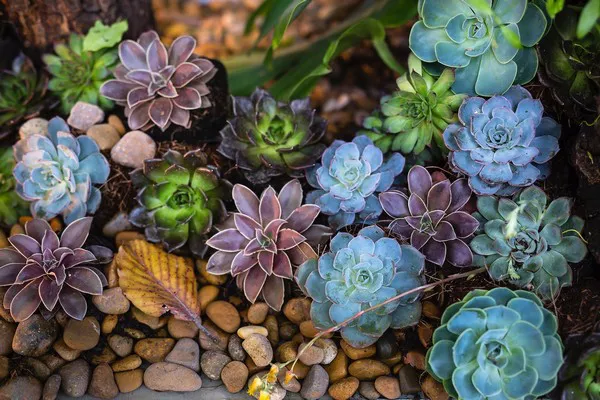Succulents, with their unique and captivating beauty, have gained immense popularity among plant enthusiasts. These resilient plants are known for their ability to thrive in arid conditions, but their success is closely tied to the type of soil they inhabit. Creating an optimal soil environment is essential for the health and vitality of succulents. In this article, we will explore the characteristics of the ideal soil for succulents, providing valuable insights for both novice and experienced gardeners.
1. The Importance of Well-Draining Soil
One of the fundamental principles in succulent care is the need for well-draining soil. Succulents are native to regions with low precipitation, where excess water can be detrimental to their health. Therefore, a well-draining soil mix is crucial to prevent waterlogging and root rot, common issues that can plague succulents in unsuitable conditions.
To achieve proper drainage, consider incorporating materials such as perlite, pumice, or coarse sand into the soil mix. These components enhance aeration and drainage, preventing water from accumulating around the roots. Striking the right balance between water retention and drainage is the key to creating an optimal environment for succulents.
2. The Role of Organic Matter in Succulent Soil
While succulents thrive in lean and well-draining soil, it is essential to include a moderate amount of organic matter. Organic matter contributes to the overall structure of the soil and provides essential nutrients for plant growth. However, excessive amounts of organic material can hinder drainage, so finding the right balance is crucial.
Incorporate well-rotted compost or organic potting mix in moderation to enhance soil fertility without compromising drainage. This will ensure that succulents receive the nutrients they need to flourish without exposing them to the risks associated with overly rich soil.
3. pH Levels and Succulent Health
The pH level of the soil plays a significant role in the health of succulents. Most succulents prefer slightly acidic to neutral soil conditions. A pH range between 6.0 and 7.0 is generally ideal for these plants. Testing the pH of your soil and making necessary adjustments can have a profound impact on the overall well-being of your succulents.
To lower pH, you can incorporate materials like sphagnum peat moss or acidic compost. Conversely, adding agricultural lime can help raise pH levels if the soil is too acidic. Regular monitoring and maintenance of pH levels contribute to the long-term success of your succulent garden.
4. The Case for Gritty Mixes in Succulent Soil
Gritty mixes have gained popularity among succulent enthusiasts for their excellent drainage properties. These mixes typically consist of inorganic components such as perlite, granite, and poultry grit, providing a gritty texture that mimics the natural conditions in succulent habitats.
Gritty mixes not only promote optimal drainage but also prevent soil compaction, allowing roots to breathe and absorb nutrients efficiently. The lightweight nature of these mixes makes them particularly suitable for container gardening, where aeration and drainage are crucial for succulent success.
5. Choosing the Right Container for Succulents
In addition to the soil composition, the choice of container plays a vital role in succulent cultivation. Selecting a container with drainage holes is imperative to prevent water from accumulating at the bottom. The container material can also influence the microclimate around the roots.
Terracotta pots, with their porous nature, allow for better airflow and moisture evaporation. This helps maintain a balanced level of moisture around the roots, preventing the soil from staying excessively wet. Conversely, plastic containers retain moisture more effectively, making them suitable for environments where higher humidity levels are desirable.
6. Adjusting Soil Composition for Different Succulent Varieties
Succulents encompass a vast array of species, each with its unique preferences and requirements. Tailoring your soil mix to the specific needs of different succulent varieties can significantly impact their overall health and appearance.
For example, cacti, a subgroup of succulents, typically thrive in even grittier and faster-draining soil than other succulent varieties. Adjusting the ratio of components in your soil mix based on the water storage capacity and growth habits of different succulents will help create an environment tailored to their individual needs.
7. The Role of Watering Practices in Succulent Soil Management
While the focus of this article is primarily on soil composition, it’s essential to briefly touch upon watering practices, as they are closely intertwined with soil health. Overwatering is a common mistake that can lead to root rot and other issues. Establishing a consistent watering routine and adjusting it based on environmental factors, such as temperature and humidity, is crucial for succulent care.
Watering should be done thoroughly but infrequently, allowing the soil to dry out between watering sessions. This approach complements the well-draining nature of the soil mix, preventing water from lingering around the roots and promoting healthy root development.
8. Troubleshooting Common Soil-Related Issues
Even with the best intentions, succulent enthusiasts may encounter soil-related challenges. Understanding common issues and their solutions is key to maintaining a thriving succulent garden.
If you notice signs of overwatering, such as yellowing leaves or mushy stems, adjust your watering frequency and ensure that the soil mix is well-draining. Conversely, if your succulents display symptoms of nutrient deficiency, consider incorporating a balanced fertilizer or top-dressing with compost to address potential nutrient deficiencies in the soil.
Conclusion
By understanding the specific needs of succulents and tailoring the soil environment to meet those needs, gardeners can ensure the long-term health and vibrancy of these captivating plants. Thoughtful soil management, combined with proper watering practices, forms the foundation for a flourishing succulent garden that will delight and inspire enthusiasts for years to come.

